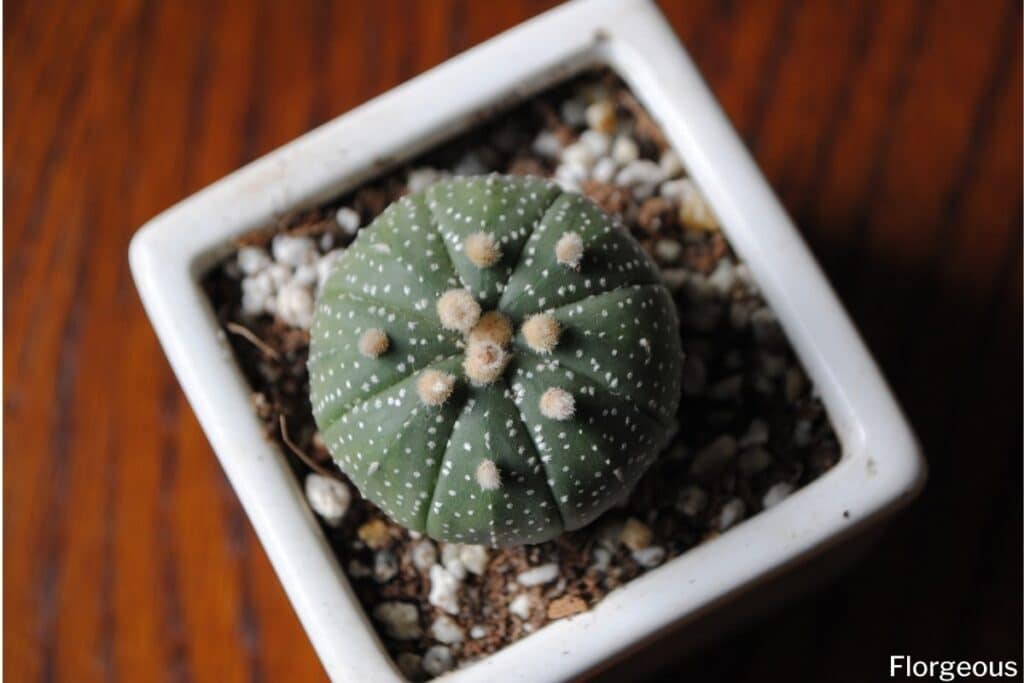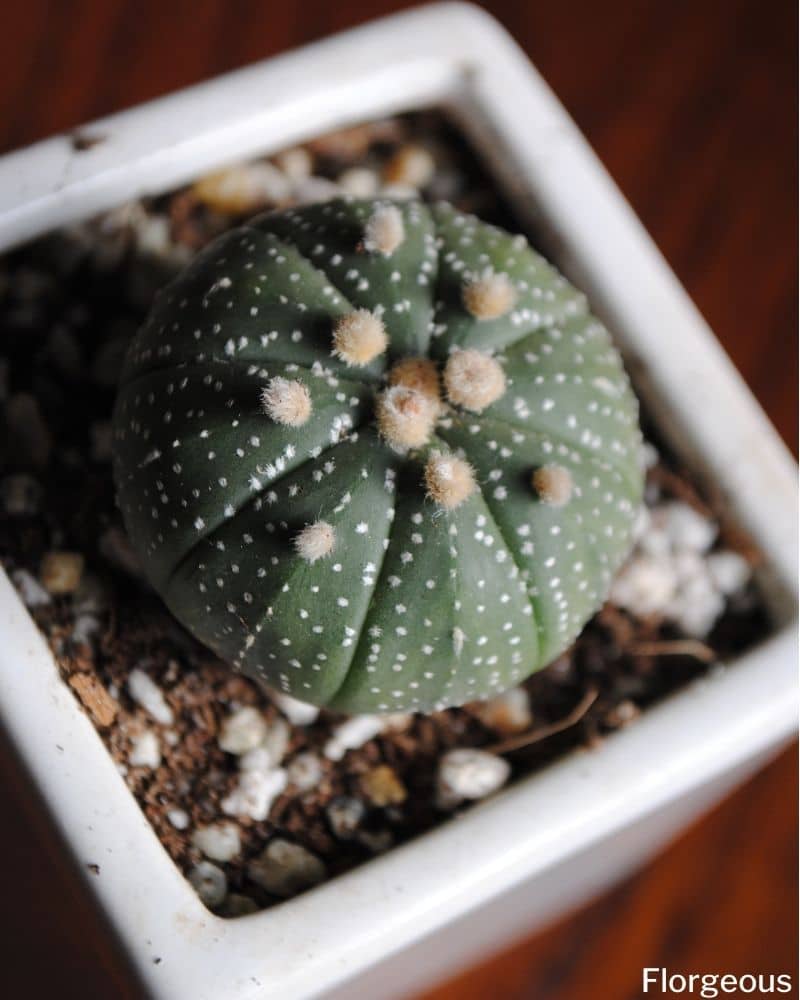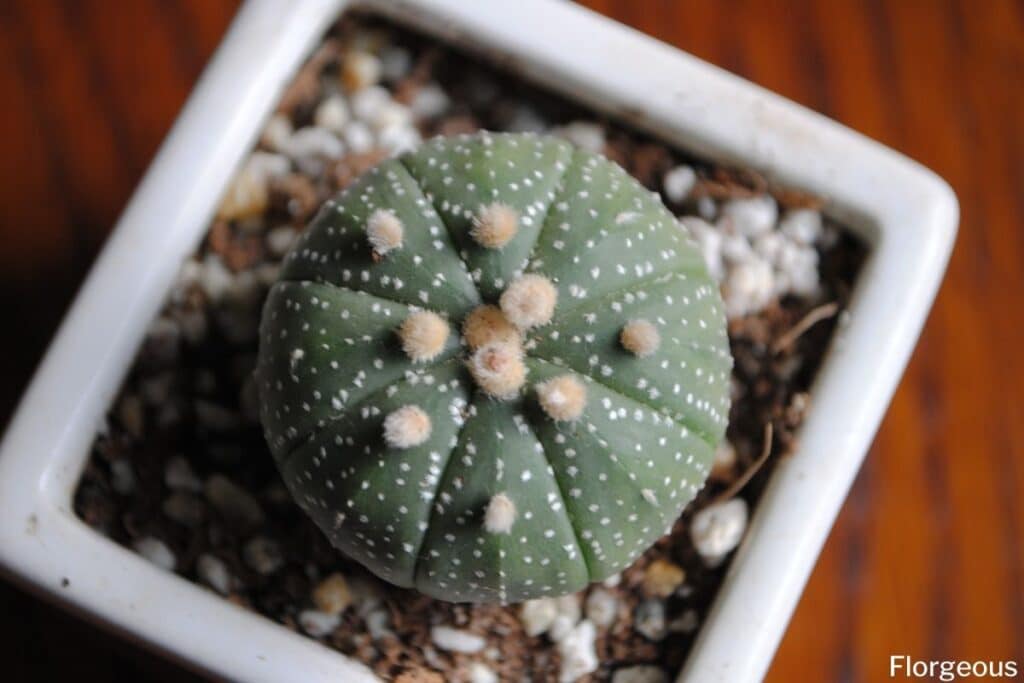One of the most fascinating things about plants is their symmetry. Often observed in the formation of flowers that are visually appealing to both animal pollinators and humans, this symmetry usually resembles cosmic patterns and shapes. But this is not limited to flowers alone; plant symmetry is also present in the leaves, roots, and stems of different plants.
The cactus family houses many species with symmetrical growth, imitating profiles like that of stones, pads, sea creatures, and stars. A popular species is the Astrophytum asterias which, as the name suggests, resembles the shape of a plump star.
Read on to learn more about this out-of-this-world cactus.
What is a Star Cactus?
The Star Cactus is a low-growing, spineless cactus that is botanically known as Astrophytum asterias. It also goes by other common names such as Sand Dollar Cactus, Sea Urchin Cactus, and Star Peyote, pertaining to the appearance of the cactus. It is shaped like a dome with pronounced, albeit shallow, 5 to 8 green to brownish green ribs.
In the wild, the growth is rather flat, almost flush with the ground, especially during dry conditions. This makes the plant quite incognito, disappearing into the dirt and under fallen leaves. Each of the triangular stem ribs is lined with white areolas covered in small white tufts.
The solitary plant can grow as tall as 7 cm (3 inches) and as wide as 15 cm (6 inches) while those grown indoors can remain rounded and fitted in a small pot, considering their slow rate of growth.
From March to May, funnel-shaped yellow star cactus flowers with orange centers appear on top of the plant, making the sand dollar cactus more noticeable. Fruiting will then commence where small reddish-pink oval fruits covered in fuzzy hairs appear in place of the drying blooms.
As suggested by one of the common names of this plant, it can be confused with the medicinal or hallucinogenic Lophophora williamsii or Peyote. The basic morphology of both plants are alike, but the differences are Peyotes are bluish-green without the white scales, their flowers are pale pink, and the roots are not as fibrous as with Star cactus (1).
Like most cacti, the Star Peyote is abundant in the hot and humid regions with high temperatures in Texas and Mexico. It was first discovered as an Echinocactus in the 1820s by a German botanist, Karwinsky, in the Mexican state of Tamaulipas and then reclassified about 20 years later (2).

Why is the Star Cactus endangered?
Throughout the years, the novelty of this plant made it popular among collectors, and together with the erroneous harvesting with peyotes, this caused a decline in its population in the wild. It is now federally listed as endangered and there has been ongoing research on how to reintroduce the plant in its natural habitat. Plants available in the market are obtained through commercial propagation techniques instead (3).
How To Grow An Astrophytum Asterias Cactus

Growing an Astrophytum asterias cactus, also known as the “Star Cactus,” requires attention to several key aspects to ensure its health and longevity:
Sunlight
Star Cacti thrive in bright indirect sunlight. Place them in a west or south facing window where they can receive at least six hours of direct sunlight daily. Protect them from the intense midday sun, as prolonged exposure can scorch their delicate skin.
Soil
To ensure that your Astrophytum asterias thrives, it’s important to plant it in nutrient-rich soil.
Aim for a blend of equal parts high-quality cactus mix, coarse perlite, and coarse sand. This combination offers excellent drainage thanks to the inorganic components.
While the organic material in the cactus mix provides essential nutrients and helps retain some moisture for your Astrophytum asterias to flourish. This will help your plant grow healthy and strong.
Water
Water sparingly, allowing the soil to dry out completely between waterings. During the growing season (spring and summer), water approximately once a week. In the dormant season (fall and winter), reduce the frequency of watering to once a month or less to prevent root rot.
Fertilizer
Feed Astrophytum asterias with a balanced, water-soluble fertilizer diluted to half strength every 4-6 weeks during the growing season to develop marvelous flowers. Avoid fertilizing during the dormant period to prevent overfeeding and potential damage to the plant.
Pruning
While these north american cacti generally require minimal pruning, remove any dead or damaged tissue with sterile scissors or pruning shears to maintain the plant’s overall health and appearance.
Diseases and Pests
Astrophytum asterias are relatively resistant to pests and diseases when provided with proper care. However, they can occasionally be affected by common cactus pests such as mealybugs or spider mites.
Inspect the plant regularly, and treat any infestations promptly with insecticidal soap or neem oil.
How to Propagate and Care for Star Cactus
In summer, when the plant is actively growing, application of fertilizer is recommended but should be in conjunction with watering.
Feeding will promote green and sturdier stems and can result in profuse and healthy blooms. However, it is important to note that over-fertilization can cause fertilizer burn and may result in elongated growth.
This practice is best timed with the repotting of the cactus, right when the nutrients from the potting media are being replenished. The aeration around the plant’s roots allows them to absorb the nutrients to support the plant’s growth (2).
What is the easy way to propagate a Star Peyote?
Propagating A. asterias by seeds from the dried flowers is rather easy but time-consuming. It can instead be grafted onto other cacti like Pereskiopsis and Echinopsis.
A micropropagation technique also proved to be highly effective in reproducing the Star cactus, not just for commercial purposes but to help repopulate the wild. This is done in the lab through the use of tissue culture technology.
Best Types of Star Cactus
#1. A. asterias f. aurea
This astrophytum cactus is a result of a mutation causing the yellow to the yellow-orange stem of the plant. Because of the lack of chlorophyll, the plant cannot tolerate long exposure to direct sun and poses a difficulty in cultivation.
#2. A. asterias f. cristatum
An even more out-of-this-world version of the sand dollar cactus, this plant showcases a fan-like wrinkled stem growth. It is usually grown grafted on another cactus but growing on its own roots is possible too.
#3. A. asterias cv. Superkabuto
“Superkabuto” is another mutation that resulted in a unique epidermis of the Star cactus covered in fuzzy white spots. Other forms also exist displaying different woolly patterns on the stem.
#4. A. asterias cv. Showa Red
This cactus is typical of Star cactus but come the blooming season, the flowers borne are quite more exquisite. The petals appear shredded and come in shades of two colors, reddish-orange, and pinkish purple.
#5. A. asterias cv. Nisiki
The “Nisiki” is a series of Star cactus appearing with variegated stems. They come in yellow and orange mixed with the original green of the stems in different patterns. Like the aurea, this cactus does not tolerate full sunlight exposure.
#6. A. asterias cv. Muscle
“Muscle” may seem like a strange-looking Star cactus, but it is among the highly prized ones. It develops a striking branching form, producing tiny side pups making the plant look knobbly or “muscled.”
FAQs
How big do Astrophytum Asterias get?
Astrophytum asterias can grow up to 6-8 inches (15-20 cm) tall and 4-6 inches (10-15 cm) wide, though they may reach larger sizes in optimal conditions.
Are Astrophytum asterias self fertile?
Yes, Astrophytum asterias is self-fertile, meaning it can pollinate and produce seeds without the need for another plant.
Is the star cactus rare?
Yes, the star cactus (Astrophytum asterias) is considered rare in its natural habitat due to habitat loss, overcollection, and illegal trade. However, it is cultivated by enthusiasts worldwide.
What does the star cactus symbolize?
Symbolically, the star cactus represents resilience, protection, and endurance. Its ability to thrive in harsh desert environments symbolizes strength and adaptability, while its star-shaped appearance has associations with guidance and hope.
Also check more types of cacti you can grow.
References
Reference List:
(1) Terry, M. et. al. A Tale of Two Cacti- The Complex Relationship between Peyote and Endangered Star Cactus. Sul Ross State University, Department of Biology. 2007. P. 115. https://www.fs.fed.us/rm/pubs/rmrs_p048/rmrs_p048_115_121.pdf. Accessed 05 April 2021.
(2) Arizona College of Agriculture and Sciences. Astrophytum asterias. The University of Arizona. 2020. https://apps.cals.arizona.edu/arboretum/taxon.aspx?id=1183. Accessed 05 April 2021.
(3) Texas Parks and Wildlife Foundation. Star Cactus. Texas Park and Wildlife Magazine. 2020. https://tpwd.texas.gov/huntwild/wild/wildlife_diversity/nongame/listed-species/plants/star_cactus.phtml. Accessed 04 April 2021.
(4) Birnbaum, S. Habitat Characterization and Pilot Reintroduction of Star Cactus (Astrophytum asterias). Texas State University. 2009. https://digital.library.txstate.edu/handle/10877/9027. Accessed 04 April 2021.
Close







